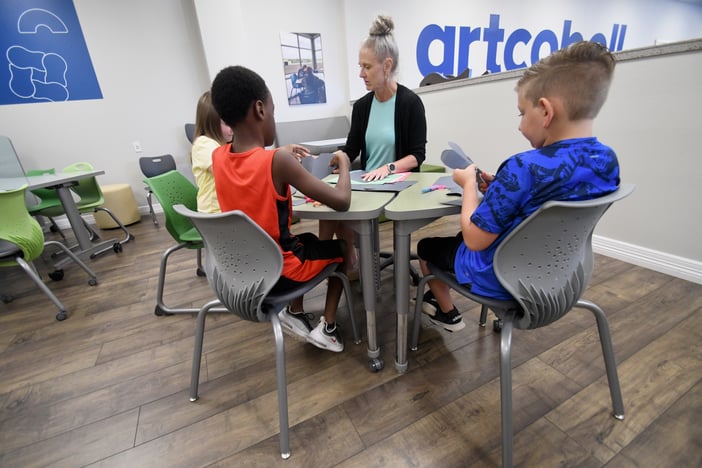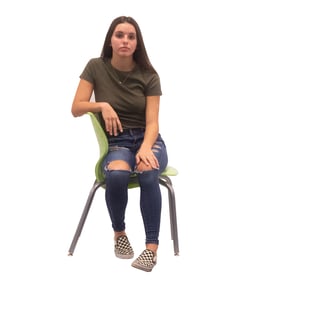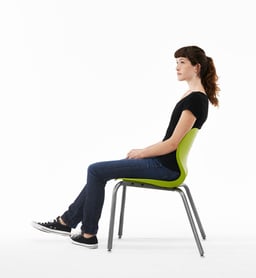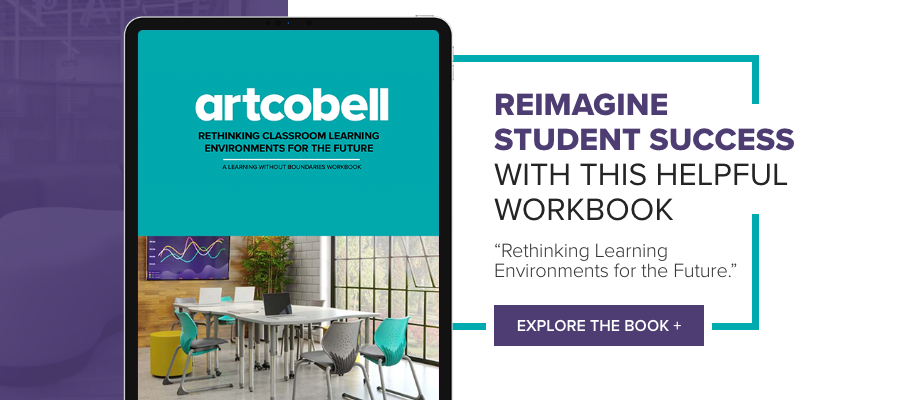We all know that flexible seating is gaining popularity in schools, but have you ever wondered why? Let’s look at the ample research on human anatomy and how humans sit. According to Dr. Tim Springer, founder of the Human Environmental Research Organization (HERO, Inc.), sitting is complicated. As a recognized expert in evaluating worker performance, ergonomics, behavior, and the environment, Springer says that even when we “sit still,” our bodies are actually constantly moving. We either need to adjust for balancing purposes or to find the most comfortable position for the activity we are accomplishing (2017, Hedge).
The Link Between Comfortable Classroom Seating & Student Success
Researchers are finding that classroom seating and combo desks that were designed for efficiency and low cost are conveying un-needed physical exertion on muscle groups, which leads to fatigue and exhaustion in students. As such, it’s no surprise that educators have placed greater importance on providing students with classroom seating and student desks that not only meets their physical needs, but that also encourages students’ academic, social, and emotional development.
The days of equipping schools with student desks made of one type of plastic base chair (either attached or not to the work surface) are gone. It goes against what we know about good ergonomics for the human body! Schools must now approach classroom seating in a way that encourages healthy sitting habits and increased activity level, which ultimately enhances student success.
Encourage Student Success Using Diverse Classroom Seating
The best way to meet the needs of students when it comes to classroom seating is to provide them with options and choices, and not just a one-size-all student desk. A variety of functional activity and task chairs with and without casters, soft seating, movement stools, height-adjustable seating, and stools with backs and backless in a classroom gives students the opportunity to find the classroom seating that they need for specific times and activities.
Four must-know tips for choosing comfortable classroom seating:
- Consider Ergonomic Standards: Be mindful of what you are putting in the classroom and how that seated surface will support your students. Be careful taking the DIY route: an assembly of personal collections or teacher-manufactured solutions may not support the needs of students or hold up to the demands of school environments. To create the best learning environment for your students, you need to truly evaluate the purpose and use of each piece of school furniture before bringing it into the classroom.
- Think comfort: evaluate each piece of classroom seating for the level of comfort for students. Consider various heights, seat pan depth, and width, hard and soft surfaces lumbar support, and curvature to ensure you’re creating the best learning environment for your various students.

PRO TIP: One of my favorite, simple solutions is to put both NXT MOV and Alphabet chairs in a room. Each has a distinct benefit for individual students. NXT MOV’s patented two-part shell design allows for independent, micro-movements that promote comfort and help kids focus.
Alphabet chairs provide students with a more relaxed seat with some flexibility to the back and a seat pan that holds them in place.


- Think Movement: NXT MOV is the solution. With the two piece frame, the “movement seat” and flexible back, students can adjust, tilt, swivel, and fidget in order to focus. Add soft seated ottomans like the Barrel Slant or Round Rocker stools so that students can more easily adjust their position.
- Think Calm: Select seating that creates a calming effect. The rocking motion of the Round Rocker or MOV Stools provides a soothing and reassuring feeling for students, allowing them to deescalate and refocus. Soft seating pieces that configure together are versatile and allow students to move around the room to create the space they need to relax.
Find the Right Classroom Seating for Your Diverse Learning Environments
As you explore the idea of flexible seating, keep in mind that our goal is to create the best learning environment for our students. In order to encourage increased attention levels, engagement, and the retention of content, use a variety of chairs and seating options (not just student desks) that help your students feel calm, comfortable, and promote concentration. Your classroom seating should create an environment that students want to learn in and one that promotes student success.
Want to learn more about flexible seating? Check out this article, How Flexible Classroom Furniture Re-Invents Learning.
Know you need more modern classroom seating, but overwhelmed by where to start? We understand! Contact our Director of Learning Environments today to get started with a plan that make sense for your students' needs and your school's budget.
Attai, S.L., Reyes, J.C., Davis, J.L. et al. Investigating the impact of flexible furniture in the elementary classroom. Learning Environ Res (2020). https://doi.org/10.1007/s10984-020-09322-1
Hedge, Alan. Ergonomic Workplace Design for Health, Wellness, and Productivity. Google Books, Boca Raton, CRC Press, 5 Aug. 2017,
Hoque, A.S.M., et al. “Ergonomic Design of Classroom Furniture for University Students of Bangladesh.” Journal of Industrial and Production Engineering, vol. 31, no. 5, 4 July 2014, pp. 239–252

